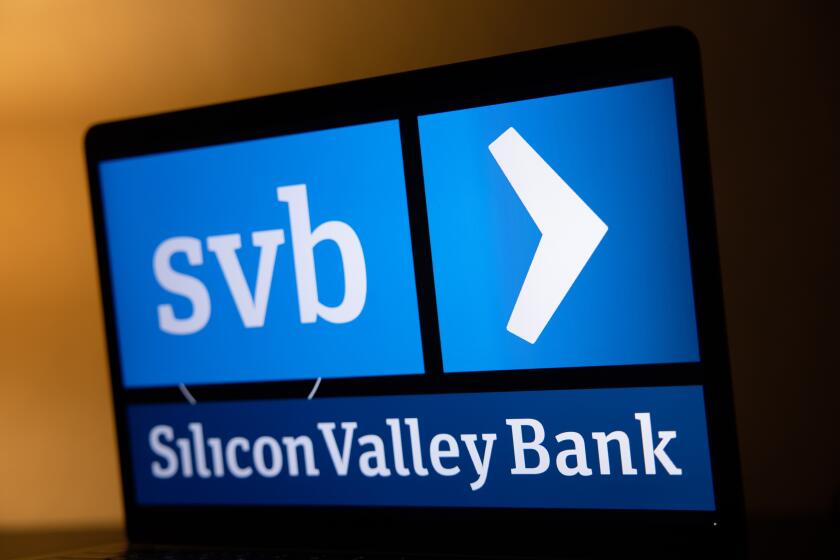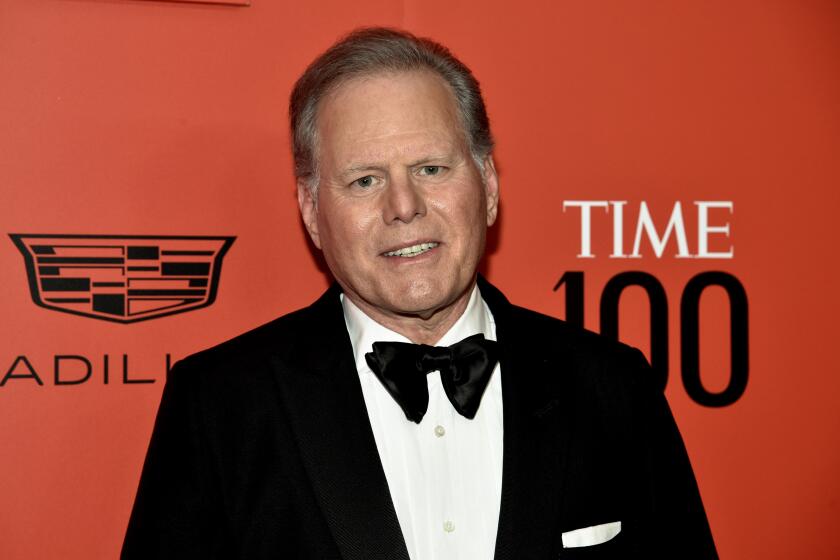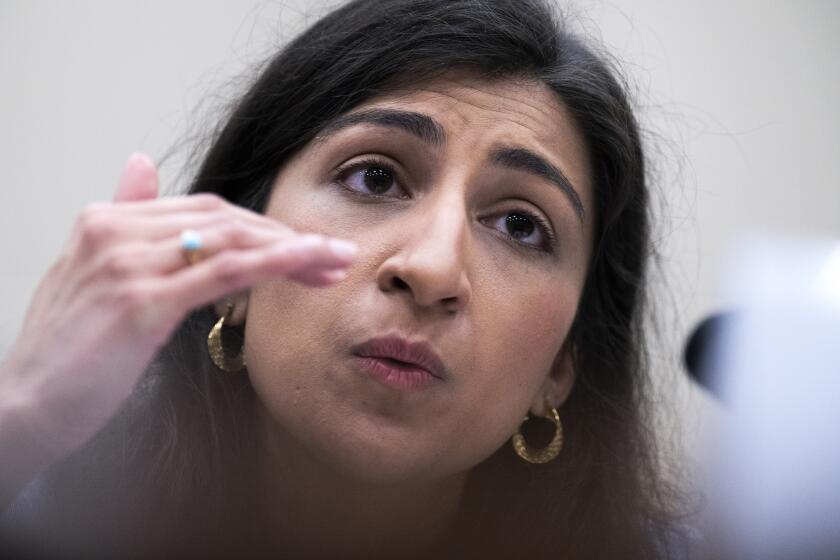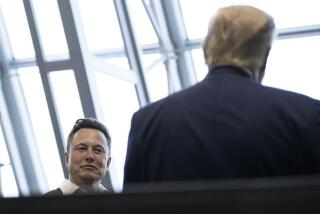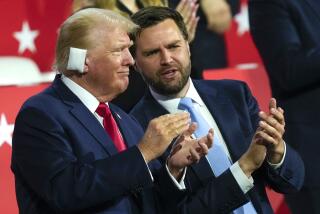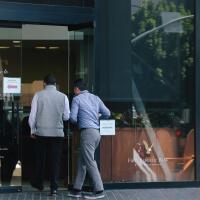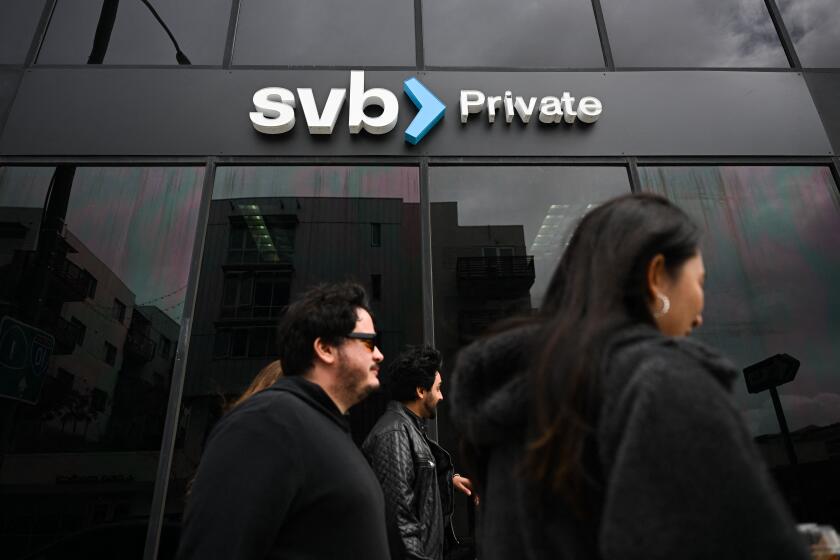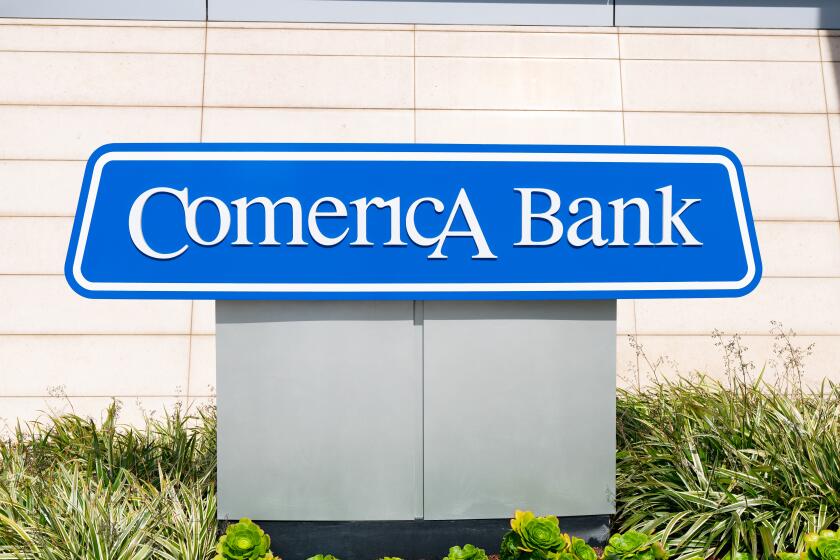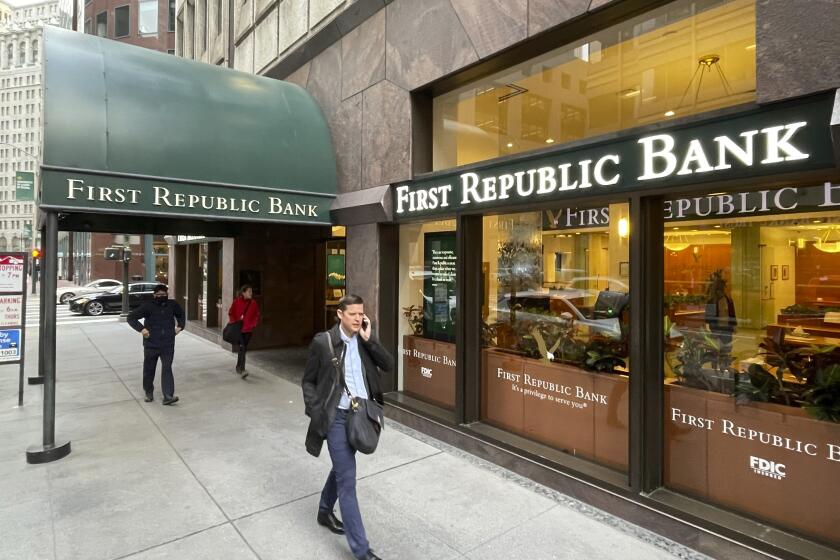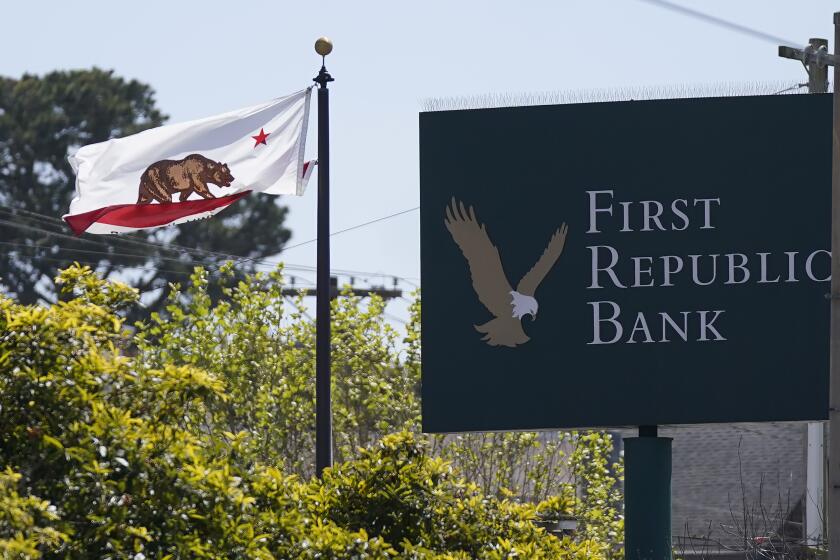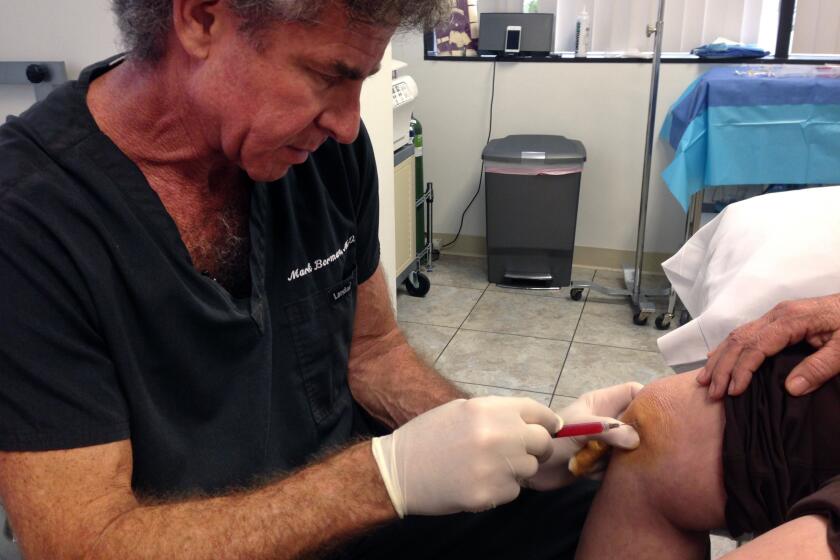Column: With demands for a bank bailout, Silicon Valley shows its ‘small government’ mantra was just a pose
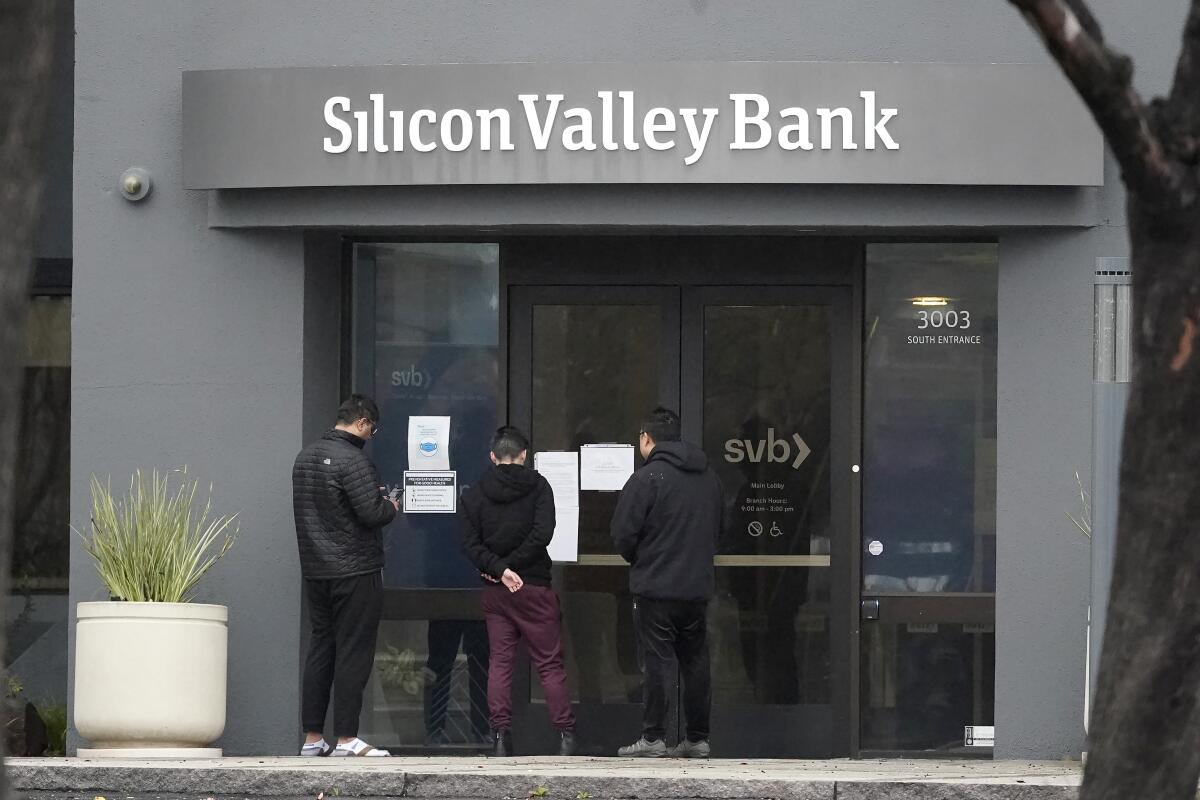
For decades, the dominant mantra of Silicon Valley‘s powerful has been that government is just a drag on their innovative spirit. Get regulators off our backs, they’ve argued, and we’ll improve people’s lives to an indescribable degree.
Not at the moment. The same investors and entrepreneurs who argued for less government and less regulation in the past successfully lobbied for a government bailout of Silicon Valley Bank, which failed Friday as a result of astoundingly imprudent business practices.
Driving their demands were the financing issues facing thousands of SVB corporate and individual customers who collectively had more than $150 billion of their cash on deposit at the bank under conditions that left it largely uninsured against the bank’s collapse.
Where is Powell? Where is Yellen? Stop this crisis NOW. Announce that all depositors will be safe.
— Silicon Valley libertarian David Sacks discovers the virtues of government action
The Federal Deposit Insurance Corp. insures individual and business deposits up to $250,000 per depositor. Many of the bank’s depositors had cash balances at SVB of hundreds of millions of dollars each.
Dispensing with that limit, the Federal Reserve, Treasury Department and FDIC announced Sunday that all SVB depositors will have access to all their money on Monday. Previously, the FDIC said it would make only the insured balances available Monday, with the balances to be repaid later and possibly not entirely.
Get the latest from Michael Hiltzik
Commentary on economics and more from a Pulitzer Prize winner.
You may occasionally receive promotional content from the Los Angeles Times.
The three agencies said no taxpayer funds would be spent on the rescue. The repayments will come from the sale of SVB’s assets, which include treasury securities, with any shortfall covered by an FDIC assessment on its member banks. The agencies may have concluded that there were enough assets on the bank’s balance sheet to cover all deposits, once the assets are sold.
This isn’t a “bailout” by the government, since SVB’s shareholders may yet be the losers; they’re not covered by the regulators’ relief program.
As it happens, the government has turned out to be the savior of Silicon Valley’s small-government libertarians in this crisis. The FDIC is one of many programs launched during Franklin Roosevelt’s New Deal that preserve Americans’ livelihoods and way of life during a crisis, and that conservatives have been trying to undermine since the 1930s.
As we reported last week, the sudden collapse of SVB resembled almost all bank runs of the past — the accumulation of huge sums of deposits that could be withdrawn on demand, backed by long-term investments that could retain their value only if held to maturity.
On Thursday, the bank announced that it needed to raise more than $2 billion in new capital, largely because long-term securities it had put up for sale had lost billions in value as interest rates rose over the last year or more.
Silicon Valley Bank failed late last week, prompting fears of wider upheaval. Here’s what you should know about the collapse and what comes next.
The announcement spooked venture investor Peter Thiel and venture firms, which advised their portfolio companies to pull their cash out of the bank.
The result was an incredible $42 billion in withdrawals initiated that day, a torrent that rendered the bank almost instantly insolvent.
The Silicon Valley Bank failure is the old story of what happens when short-term depositors want their money back from a bank with only long-term assets.
California regulators and the FDIC shuttered the bank Friday morning. When that happened, the shaky foundations of the bank’s business model were exposed to daylight, and the cries for a government bailout of its customers swiftly followed.
The context of these events was a fundamental change in the economics of the high-tech and biotech companies the bank served. As interest rates moved higher, its clients had more difficulty raising funds from private investors and therefore relied more on their cash balances at the bank. Their markets shrank, intensifying the rate at which they were burning cash.
It’s not unusual for a crisis to turn people’s most cherished beliefs on their head. The old joke says a conservative is a liberal who’s been mugged, and a liberal is a conservative who’s been sent to jail. An old military saw has it that “there are no atheists in foxholes,” an insight that investment commentator Barry Ritholtz expands to read, “there are also no Libertarians during a financial crisis.”
One other immutable principle of American capitalism is at play: The goal in business to privatize profits and socialize losses. In other words, when things are good, companies will keep their profits for distribution to shareholders. When things turn sour, the cry is heard for government to step in with bailouts and subsidies.
What’s overlooked in this case is that Silicon Valley Bank’s problems were in part the consequence of a Trump-era deregulation movement in banking that was fully backed by the banking industry and the management of — yes — Silicon Valley Bank itself. More on that in a moment. But first, let’s call the roll of small-government advocates who got their wish for a big-government bailout.
Start with billionaire hedge-fund operator Bill Ackman, who has advocated for self-regulation by the cryptocurrency sector and has pushed back against efforts by the Securities and Exchange Commission to regulate one of his investment funds. Ackman went all-in for Donald Trump after Trump’s election in 2016, gushing that the U.S. has been “undermanaged for a very long period of time. We now have a businessman as president.”
The Wall Street Journal says America ‘soaks the affluent.’ Try to hold back your tears.
In a lengthy tweet Saturday, Ackman flayed banking regulators for “allowing [SVB] to fail without protecting all depositors,” which he called “a-soon-to-be-irreversible mistake.”
He added, “Already thousands of the fastest growing, most innovative venture-backed companies in the U.S. will begin to fail to make payroll next week. Had the gov’t stepped in on Friday to guarantee SVB’s deposits ... this could have been avoided and SVB’s 40-year franchise value could have been preserved.”
Then there’s David Sacks, an intimate of Thiel and Elon Musk, who were his partners in establishing and growing PayPal. Sacks and his friends have promoted a worldview that opposes progressive laws and regulations, including those aimed at reining in economic inequality.
Appearing on Megyn Kelly’s Sirius XM satellite show June 7, the day of the successful recall vote against San Francisco’s progressive district attorney, Chesa Boudin — a recall movement Sacks helped to finance — he called Democrats “useful idiots for the Chinese Communist Party.”
By this weekend Sacks was squealing: “Where is Powell? Where is Yellen? Stop this crisis NOW. Announce that all depositors will be safe.” (His references are to Federal Reserve Chair Jerome H. Powell and Treasury Secretary Janet L. Yellen.)
Venture investor Brad Gerstner called in a tweet for the Federal Reserve to “act now to make sure depositors are 100% protected.” In a second tweet, he asserted that the savings of thousands of small investors are at risk “just [because] the system failed.”
That drew a horselaugh from veteran investor Jim Chanos, whose experience as a short-seller has given him a uniquely percipient feel for Wall Street foibles. “The chutzpah here beggars belief,” Chanos replied on Twitter.
Chanos observed, accurately, that it was venture investment firms that actually launched the run on SVB on Thursday, when they suddenly urged their companies to pull their deposits from the bank, triggering the $42-billion outflow. “And they now want the Taxpayer to bailout their investments…?! Capitalism, Silicon Valley-style.”
It’s not only the entrepreneurial brotherhood demonstrating that, to quote what has become known as Miles’ Law, “Where you stand depends on where you sit.”
Despite pandemic closures and more shareholder votes against their pay, CEO compensation keeps soaring. But there are signs the backlash is working.
Consider former Treasury Secretary Lawrence H. Summers, who last year was heard disdaining President Biden’s student loan relief as inflationary. His argument was that the $10,000 to $20,000 in proposed relief “consumes resources” better used to help those who don’t attend college, and invites colleges to raise tuitions.
By Friday, however, Summers was saying that it’s “absolutely imperative” that “all depositors be paid back and paid back in full.” Interestingly, the same cadres who argue that student loan borrowers should have known what they were getting into when they took out their loans were able to overlook that Silicon Valley Bank depositors should have known that deposits beyond $250,000 are uninsured and therefore not guaranteed to be paid back.
(Miles’ law was coined by then-federal budget official Rufus E. Miles Jr. in the 1940s, after he noticed that after his most hard-nosed budget examiner took a job at one of the agencies he had criticized, the examiner became that agency’s most devoted defender against the unwarranted critiques from the budget office.)
Libertarian-minded Silicon Valley types have been trying to blame the bank’s collapse on the Fed. Cryptocurrency promoter Balaji Srinivasan, for example, complained that “Powell said that he wouldn’t raise rates in April, June, July, and Oct 2021 ... People trusted him ... And that’s how the Fed caused the crisis.”
That’s absurd, of course. The Fed began its sequence of interest rate increases in March 2022 and brought them higher by 4.75 percentage points from then through January this year. At every step the central bank made its intentions crystal clear. By early 2022, people “trusted” that the Fed was on a long-term rate tightening campaign. Absolutely no one had a right to be surprised.
Two key factors in the SVB disaster can’t be overlooked: The incompetence of the bank’s management and the improvidence of its customers.
The value destruction taking place in the bank’s holdings of long-term securities was written in bright red on its ledger books. With the prospect of interest rate increases continuing through 2022 and into this year, its management had no excuse for failing to unwind its holdings well before now instead of waiting.
Under regulations implemented in accordance with the Dodd-Frank banking reform law of 2010 safety-and-soundness standards were tightened for banks with more than $50 billion in assets.
Those larger banks were required to submit annual disclosures to the Fed, meet stricter liquidity and risk management requirements, and undergo “stress testing” that would reveal how they would fare under extreme financial scenarios.
Noncompete clauses push down wages and trap workers in lousy jobs, so of course they’re beloved by employers. The FTC wants to change that.
Mid-sized banks launched a vigorous lobbying campaign to raise that threshold. In testimony submitted to the Senate Banking Committee in 2015, Greg Becker, the chief executive of Silicon Valley Bank, called for raising the threshold as high as $250 billion.
Becker’s statement bristled with the buzzwords and catchphrases beloved of Silicon Valley entrepreneurs. He asserted that without the change, the regulations would be so burdensome that “SVB will likely need to divert significant resources from providing financing to job-creating companies in the innovation economy.”
Becker referred to “SVB’s deep understanding of the markets it serves, our strong risk management practices, and the fundamental strength of the innovation economy.”
As it happens, SVB plainly didn’t understand how the markets it serves were vulnerable to lock-step flight from its deposit accounts, had weak or paltry risk-management practices, and failed to recognize that the innovation economy has its ups and downs.
The industry’s lobbying yielded fruit. President Trump raised the Dodd-Frank threshold in 2018. At the signing ceremony, Trump labeled the regulations “crushing.” He said, “Those rules just don’t work.”
Actually, they would have worked well for Silicon Valley Bank, which exceeded the $50-billion asset threshold in 2017 and never reached the $250-billion level, having topped out last year at $211.7 billion in assets. Had the old rules remained in place, it would have become subject to stricter oversight no later than 2018. Regulators might have noticed its rapid growth and the shortcomings of its risk profile. But they never had the chance.
Finally, the customers. SVB evidently required some of its Silicon Valley borrowers to do all their banking through the bank as a condition of their loans. According to its annual disclosures, the bank paid an average of 2.2% on savings and checking accounts last year; that’s higher than most commercial banks, but not high enough to compensate for the risk of uninsured cash deposits.
Some companies have reported uninsured balances of hundreds of millions of dollars sitting at SVB. It’s not unusual for businesses to have sizable balances in bank accounts exceeding the insurance cap. But prudent companies spread their deposits around, so they’re not mortally exposed to the failure of any one depository institution.
Multiple options exist for parking cash, such as investing in short-term government securities, money market instruments and corporate commercial paper. None of these is government-insured, but they offer diversification and a cushion against a single bank’s implosion.
With the debacle apparently resolved, the bank’s clients and their employees can enjoy the peace of mind that comes with a well-regulated banking system. Even at the businesses whose leaders lobbied to make banking less safe for everyone.
More to Read
Get the latest from Michael Hiltzik
Commentary on economics and more from a Pulitzer Prize winner.
You may occasionally receive promotional content from the Los Angeles Times.

